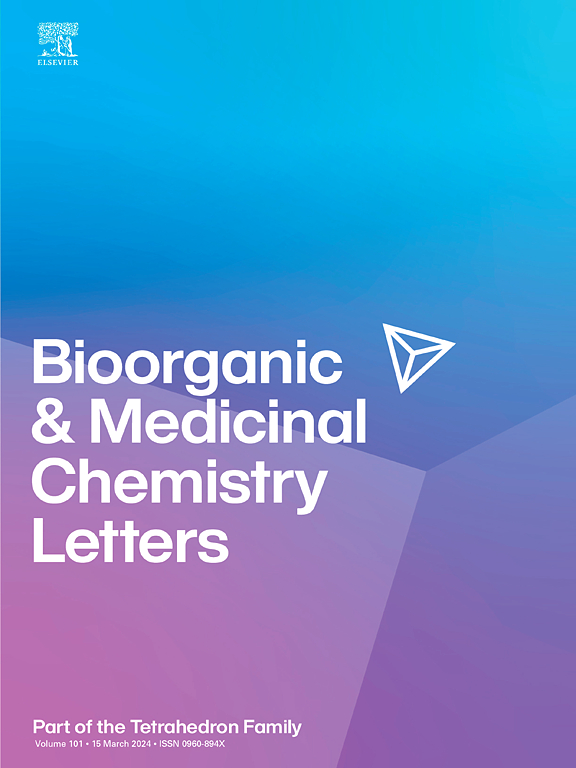Recent progress in synthetic strategies to develop potent, HDAC8-selective, small-molecule inhibitors
IF 2.2
4区 医学
Q3 CHEMISTRY, MEDICINAL
引用次数: 0
Abstract
Key players in epigenetic control, the 11 zinc-dependent histone deacetylase (HDAC) enzymes have been affirmed as therapeutic targets, particularly in the discovery of new chemotherapy drugs: currently there are 3 FDA-approved pan-HDAC inhibitors (HDACi's), although these are not without their side effects. It has been rationalized that achieving HDAC isoform-selective inhibitors may yield safer drugs. HDAC8 has recently been validated as a novel target for the treatment of (pediatric) neuroblastoma, and its overexpression has been implicated in a range of other diseases. Herein, we discuss the topology of the HDAC8 active site in the context of inhibitor design, and we present recent progress in the discovery of potent, HDAC8-selective small-molecule inhibitors, with a discussion on the particular structural criteria required. HDACi's largely conform to a canonical pharmacophore model of a capping group connected via a linker to a zinc binding group (ZBG), which is typically a (potentially mutagenic) hydroxamic acid. In particular, for HDAC8-selectivity, the small-molecule should adopt a geometric “L”-shape, which may be accomplished by the linker itself, or the linker and capping group. More recently, HDAC isoform selectivity has been realized with hydroxamic acid surrogates, such as ortho-aminoanilides that yield potent and HDAC1-3-selective (but HDAC8-inactive) inhibitors. Hydrazides have long been utilized as bioisosteres of hydroxamic acids in HDAC inhibitor design, but a recent re-visiting explored the attachment of alkyl groups, and an n-hexyl substituent on the distal, non-acylated nitrogen affords potent and selective HDAC8 inhibitors probably through targeting the foot pocket of the active site; this discovery was observed across three different HDACi scaffolds, and thus appears quite general. α-Aminoketo ZBGs have also demonstrated HDAC8-selectivity, with associated benzylic moieties likewise engaging the foot pocket. We speculate that a re-imagining of the ortho-aminoanilide ZBG through a careful and methodical survey of related moieties, may lead to the discovery of additional HDAC8-selective ZBGs towards the realization of safe, pre-clinical inhibitors.
2025 Elsevier Ltd. All rights reserved.

高效、hdac8选择性小分子抑制剂的合成策略研究进展。
11种锌依赖性组蛋白去乙酰化酶(HDAC)在表观遗传控制中起着关键作用,已被证实为治疗靶点,特别是在发现新的化疗药物方面:目前有3种fda批准的HDAC抑制剂(HDAC’s),尽管它们并非没有副作用。实现HDAC异构体选择性抑制剂将产生更安全的药物,这是合理的。HDAC8最近被证实是治疗(儿科)神经母细胞瘤的新靶点,其过表达与一系列其他疾病有关。在此,我们讨论了HDAC8活性位点在抑制剂设计背景下的拓扑结构,并介绍了最近在发现有效的HDAC8选择性小分子抑制剂方面的进展,并讨论了所需的特定结构标准。HDACi在很大程度上符合典型的药效团模型,即通过连接物连接到锌结合基团(ZBG),通常是(可能致突变的)羟肟酸。特别是对于hdac8的选择性,小分子应呈几何“L”形,这可能是由连接子本身完成的,也可能是由连接子和旋盖基团完成的。最近,羟肟酸替代物的异构体选择性已经实现,如邻氨基苯胺,产生有效的和hdac1 -3选择性抑制剂。长期以来,肼类化合物一直被用作HDAC抑制剂设计中羟肟酸的生物同分异构体,但最近重新研究了烷基的附着,以及远端非酰化氮上的正己基取代基,通过靶向活性位点的脚袋,提供了有效的选择性HDAC8抑制剂;这一发现是在三种不同的HDACi支架上观察到的,因此看起来很普遍。α-Aminoketo zbg也显示出hdac8选择性,相关的苯基部分同样参与足袋。我们推测,通过对相关部分的仔细和系统的调查,重新想象邻氨基苯胺,同样可以发现进一步的hdac8选择性和安全的临床前抑制剂。爱思唯尔有限公司版权所有。
本文章由计算机程序翻译,如有差异,请以英文原文为准。
求助全文
约1分钟内获得全文
求助全文
来源期刊
CiteScore
5.70
自引率
3.70%
发文量
463
审稿时长
27 days
期刊介绍:
Bioorganic & Medicinal Chemistry Letters presents preliminary experimental or theoretical research results of outstanding significance and timeliness on all aspects of science at the interface of chemistry and biology and on major advances in drug design and development. The journal publishes articles in the form of communications reporting experimental or theoretical results of special interest, and strives to provide maximum dissemination to a large, international audience.

 求助内容:
求助内容: 应助结果提醒方式:
应助结果提醒方式:


